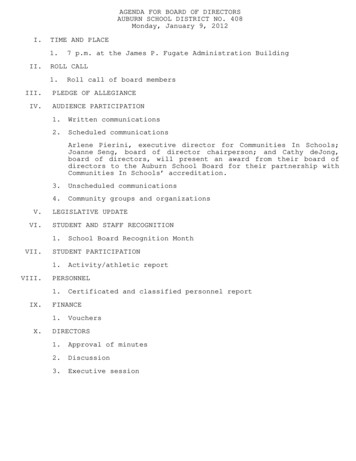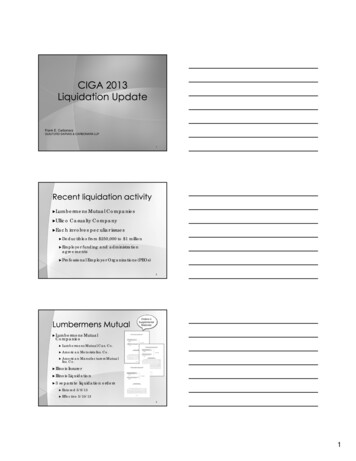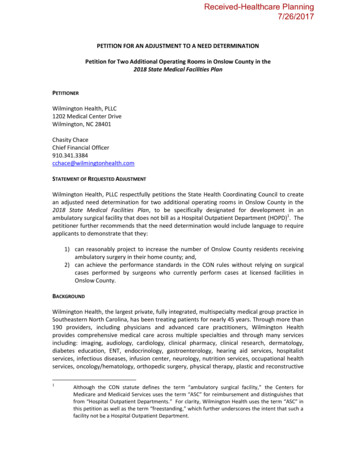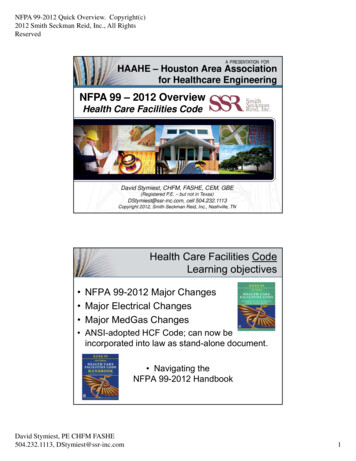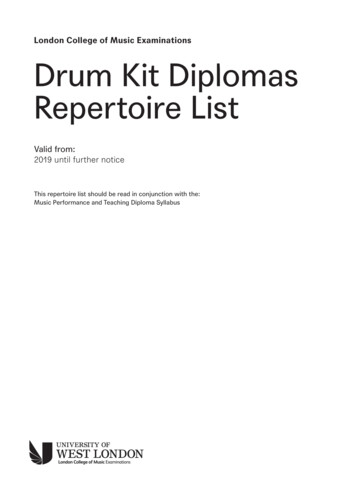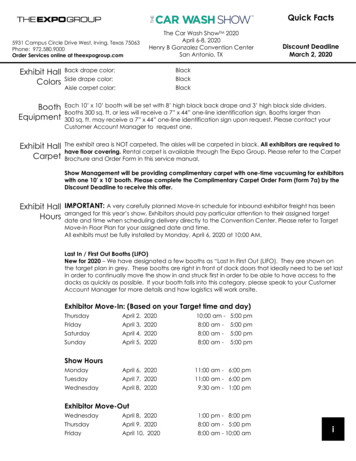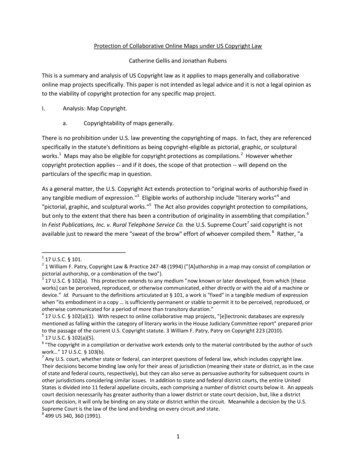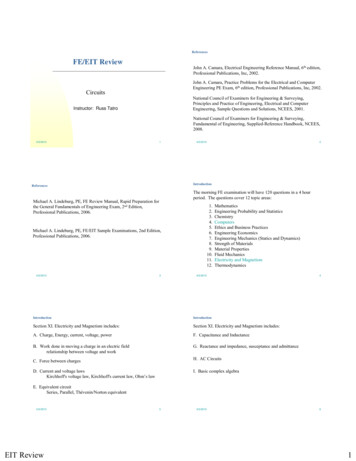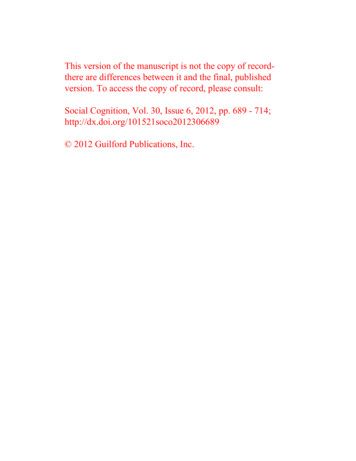
Transcription
This version of the manuscript is not the copy of recordthere are differences between it and the final, publishedversion. To access the copy of record, please consult:Social Cognition, Vol. 30, Issue 6, 2012, pp. 689 - 714;http://dx.doi.org/101521soco2012306689 2012 Guilford Publications, Inc.
Approaching Relief:Compensatory Ideals RelieveThreat-Induced Anxiety by PromotingApproach-Motivated StatesIan McGregorYork UniversityMike PrenticeUniversity of MissouriKyle NashUniversity of BaselWe propose that in anxious circumstances people are drawn toward idealistic meanings and purposes because ideals efficiently and reliably engageapproach motivated states. We present evidence that approach motivationand anxiety are inversely related; that approach motivation and anxiety arepositively and negatively associated with meaning in life, respectively; andthat ideals are more reliable vehicles than concrete goals for sustainingmeaning, approach motivation, and relief from anxiety. We suggest thatvarious threats arouse anxiety because they generate goal conflict, reviewevidence for a reactive approach-motivation (RAM) interpretation of idealistic and worldview defense (Nash, McGregor, & Prentice, 2011), andintegrate consistency, terror management, self-affirmation, and attachmentrelated theories of threat and compensatory defense from a RAM theoryperspective. We conclude with a RAM account for why compensatory defenses tend to be idealistically conservative, group-based, and religious,and how they can be either antisocial or prosocial.Most contemporary theories of psychological threat and defense still, like Freud100 years ago, posit a fundamental psychological commodity that is hydraulicallyundermined by threats and restored by compensatory defenses. Freud (1905/1962)
maintained that sexual gratification was the fundamental commodity. Its frustration caused anxiety and a diverse range of sometimes obvious (fetishes) andsometimes oblique (super-ego-related) defense mechanisms. Theories of threatand compensatory defense seem most reasonable when the defense obviously addresses the threat, for example, sexual conflicts causing perversions, death anxiety boosting belief in an afterlife, or failure boosting claims to be a good personin some other way (Freud, 1905/1962; Greenberg, Solomon, & Pyszczynski, 1997;Steele, 1988). In our view, however, theories of threat and compensation tend tobecome less parsimonious when extended to idealistic and meaningful kinds ofdefenses. For example, in his theorizing about the Oedipus complex Freud maintained that people react to ambivalence about their sexuality by identifying withthe father’s moral worldview in order to win the mother’s affection, or by givingback to society in a generative way that symbolically sublimates sexual needs.Terror Management Theory posits that people overcome death anxiety by adhering to their self and worldview ideals to regain a sense of symbolic immortality.Self-affirmation theory posits that people exaggerate their self and value idealsbecause doing so restores the commodity of self-integrity, a global sense of moraland adaptive adequacy.As fruitful as these and other fundamental commodity perspectives continue tobe, we propose that it may be time for an integration of compensation theories anda loosening of the fundamental commodity assumption. We agree that people willoften find an alternative way to restore a psychological commodity that has beenthreatened. When the commodity cannot be readily restored, however, we propose that people turn to worldviews for mere anxiety relief rather than for restoration of any particular commodity. Threats cause anxiety, and if the threat cannotbe directly resolved, people will mount idealistic and worldview defense reactionsbecause doing so effectively relieves anxiety. As will be discussed in detail below,ideals powerfully activate approach motivation processes, and approach motivation automatically quells anxiety.We propose that people are drawn toward approaching meaningful ideals andworldviews because doing so reliably activates approach motivation without riskof becoming mired in the conflicts and complication that can impede the approachof concrete incentives. Meaningful ideals and worldviews also provide efficient relief because they can be instantaneously promoted in private imagination, withoutexpenditure of physical resources.In the following sections we review some ideas on the psychology of idealistic meaning, in contrast to happiness, in order to set the stage for our reactiveapproach-motivation (RAM) interpretation of threat and idealistically meaningfulcompensatory defenses. We propose that the anxiety-induced quest for idealisticmeaning, and the special capacity of idealistic meanings to relieve anxiety, is oneof the oldest themes in the humanities. It is also a core premise of both Easternand Western philosophy, and of most major religious traditions. After highlightingthe psychological distinction between relatively concrete happiness and idealisticmeaning, we review some of our recent evidence that idealistic meaning in life ispositively and negatively associated with approach motivation and anxiety, respectively, and that approach motivation and anxiety are negatively correlated.We then review evidence that ideals are particularly effective vehicles for sustaining meaning, approach motivation, and relief from anxiety. We interpret compensatory defenses from a goal-regulation perspective on anxiety and RAM. We con-
clude with a discussion of why compensatory defenses tend to be idealisticallyconservative, group-based, and religious, and how they can be either antisocial orprosocial.Approaching Idealistic Meanings:Beyond Transient HappinessMost people would consider caring for a sick child as meaningful but less pleasant and consuming chocolate as pleasant but less meaningful. Lives exclusivelycharacterized by indulgence in pleasures such as eating, drinking, casual sex,shopping, and entertainment can seem vacuous (King & Napa, 1998). Preoccupation with personal success can also feel hollow (Kasser & Ryan, 1993). Imaginea young woman’s life characterized exclusively by immersion in hedonistic andambitious pursuits. For a while she might feel invigorated by her high life in thefast lane. Over time however, she might come to feel as if something were missingand gravitate toward a different way of life. She might look for meaningful work,deeper relationships, or cultivate a personal spirituality, which could all help herwake up in the morning with a more idealistically inspiring sense of purpose thanamusement or winning the rat race. Why might the pursuit of pleasure and success leave people longing for more idealistic meanings? We think it is because ideals are particularly effective at sustaining approach motivated states that can keeppeople feeling buoyant and vital even in anxious circumstances.The quest for meaning is featured in the 3700-year-old Sumerian story of theheroic Gilgamesh and his despair upon realizing that even with his considerableaccomplishments he will die and “become like mud” (Guirand, 1977). The sametheme is featured in the biblical book of Ecclesiastes with the wealthy King Solomon’s jaded lament that “all is vanity and striving after wind” (Ecclesiastes 1:14,The King James Bible). Longing for meaning is also the topic of the best-selling nonfiction hard-cover book of all time, The Purpose Driven Life: What on Earth Am IHere For? (Warren, 2002; this book sold over 50 million copies in 10 years). Despitethe prevalence of meaninglessness and the quest for meaning as a perennial human preoccupation, the psychological processes behind it and the maintenance ofmeaning have been elusive. So much so that an exhaustive review of philosophicaland clinical work related to meaning in life concluded with the observation thatwith regards to the question of meaning the best one can do is ignore the questionaltogether and “embrace the solution of engagement rather than plunge in andthrough the problem of meaninglessness . . . the question of meaning in life is asthe Buddha taught, not edifying. One must immerse oneself in the river of life andlet the question drift away” (Yalom, 1980, p. 483).For someone in the grips of meaninglessness, however, this advice might seemglib. Extremes of meaninglessness are agonizing and not easy to ignore, and theproblem is precisely that nothing seems worthy of immersion. Indeed, meaninglessness is highly correlated with feelings of anxiety and depression, and its empirical distinction is based on a perceived lack of purpose (McGregor & Little, 1998).Accordingly, desperate efforts at concrete engagement as a meaning-maintenancesolution can tend to be compulsive, extreme, rigid, and hostile, and come at a costto self and others (Baumeister, 1991; Fromm, 1941, 1973; see also Heine, Proulx, &Vohs, 2006). Clearer understanding of the basic motivational dynamics of idealis-
tic meaning could therefore have important personal and social implications. Wesubmit that understanding these dynamics also illuminates the basic motivationfor idealistic compensatory defenses that people mount in anxious circumstances.We propose an approach-motivation account of idealistic meaning and worldview defense based on two premises: (a) ideals efficiently and reliably maintainapproach motivation, and (b) approach motivated states automatically constrainmotivational focus and relieve anxiety. With regard to the first premise, ideals arepowerful levers for approach motivation (Amodio, Shah, Sigelman, Brazy, & Harmon-Jones, 2004; Higgins, 1997), and should therefore be expected to induce thesharpened sense of clarity and coherence that approach motivation confers. Focusing on abstract ideals that transcend the relative chaos of daily existence shouldalso directly highlight a subset of familiar and expected associations afforded bythe clear idealistic focus. This clarity of focus could immediately support a sense ofcoherence and connection associated with meaning (Heine et al., 2006; cf. Landauet al., 2004; Vess, Routledge, Landau, & Arndt, 2009).With regard to the second premise, approach motivated states powerfully changeaffect and cognition. They directly downregulate anxiety and thereby release feelings of potency and vigor (Corr, 2008; Drake & Myers, 2006; Keltner, Gruenfeld, &Anderson, 2003; Nash, Inzlicht, & McGregor, 2012). They also constrict the scopeof awareness to an internally consistent subset of goal-relevant perceptions (e.g.,Harmon-Jones & Gable, 2009; Harmon-Jones, Schmeichel, Inzlicht, & HarmonJones, 2012). The resulting coherence in the subset of incentive-relevant perceptions, shielded from motivationally extraneous distractions (Shah, Friedman, &Kruglanski, 2002), confers a sense of clarity, connection, wholeness, and harmony.Together, the affective and cognitive changes liberate the experience of vitality,unity, conviction, and confident purpose that people recognize as meaning.These links between ideals, approach motivation, and anxiety relief may helpexplain not only idealistic and approach-motivated reactions to various anxiousuncertainty threats (McGregor, Gailliot, Vasquez, & Nash, 2007; McGregor, Nash,Mann, & Phills, 2010; McGregor, Nash, & Prentice, 2010), but also why philosophical and religious views on meaning perennially focus on ideals. Hindu enlightenment, liberation, and sustainable well-being, for example, are attained by renouncing attachments to temporal goals for pleasure and success and yoking oneself toidealistic goals, such as selflessness (Karma yoga), love (Bhakti yoga), truth (Jnanayoga), or self-control (Raja yoga), that transcend the nagging wants of the temporal world (Smith, 1986).Eudaimonia is Better than HedoniaPlato, and to some extent Aristotle, similarly proposed that lives feel most vitalwhen oriented toward universal abstractions beyond temporal reality. Plato’s allegory of the cave portrayed the state of shackled devotion to shadowy phenomenalpleasures as drudgery in contrast to the more meaningful bliss derived from intentional devotion to apprehending transcendent ideals. Aristotle also distinguisheda more trivial kind of happiness (hedonia) from a more sublime kind of flourishing(eudaimonia) that arises from the rational activity of humans’ essential, divine intellect (nous) in recognizing the abstract universals that observable particulars represent. The Greek recognition of the motivational premium provided by idealistic
and essentialistic engagement has been referred to as “the passion of the Westernmind” that has so powerfully animated subsequent Western cultures and religionswith meaning and motivational sway (Tarnas, 1992). Christianity and Islam support meaning for more than half of the people in the world, and both float on theidealistic and essentialistic premises that they absorbed from Greek philosophy(Armstrong, 1993; Durant, 1939; Tarnas, 1992). Aristotle’s views of eudaimoniareflected this emphasis on effective action. Eudaimonia is not only supported bycontemplation of rational, universal truths, but also by application of the rational capacity for living and doing well through excellence and balance in action.As people actualize their essential capacities for rational thought and action theyexperience eudaimonic self-actualization (Tarnas, 1992). Consider the example ofsomeone deciding whether or not to indulge in some transient pleasure that isinconsistent with his or her ideals, such as binging on chocolate or having an illicitfling. Doing so would enhance approach motivation up until consummation, butthe hedonia would be fleeting and the residual conflict with personal ideals wouldundermine eudaimonia. In contrast, abstaining from the transient pleasure mightmomentarily restrain approach motivation for the duration of the temptation. Butafter the restraint, reflection on how the momentary restraint was consistent withpersonal ideals could reactivate a more sustained approach motivation.This basic idea of meaningful flourishing arising from linkage between goalsand a personal essence or ideal remained when the psychology of meaning becamepopular in the 1960s under the banners of existential and humanistic psychology.People were thought to experience meaningful well-being to the extent that theywere able to self-actualize toward an identity-ideal. An important change in theGreek to the humanistic transition, however, was that existentialism and modernity rendered the identity-ideal a moving target. Rather than striving to realize anormative ideal or rational essence, humans became free to create a personalizedidentity-ideal to guide their subsequent behavior (cf. Baumeister, 1986; Gergen,1991). The existential revolution turned on the notion that existence precedes essence. People first find themselves existing and they then struggle to construct anidiosyncratic personal essence or identity that is no longer divinely or traditionallypredetermined (e.g., Heidegger, 1962/1927; May, 1961). With this transition thefocus shifted from an action-based emphasis on virtue as arising from normativelyrational action, to a more introspective emphasis on virtue as finding oneself, deciding how to be, think, and act, and having the courage to face the related uncertainties and crises (Baumeister, 1986; Erickson, 1968; Fromm, 1941; Tillich, 1954).After a period of theoretical fascination with the vicissitudes of self-actualization, as represented in psychodynamically influenced clinical-existential theories(reviewed in Yalom, 1980), academic scholarship on personal integrity and meaning in life waned. Hard-nosed psychologists were turned off by the “carnival atmosphere” of the meaning-seeking movement in the 1960s (Yalom, 1980, p. 19).The emphasis on introspection, drug use, and spirituality had made meaningseem more like a magical mystery tour than a basic experience of living and thriving in the real world, much less something that could be precisely measured withobjective scientific tools. At the same time an exhaustive review of the existentialphilosophy and clinical psychology literatures concluded that meaning does notarise from introspective speculation. Instead, it is a function of the capacity for sustained engagement in the everyday activities of life. In his exhaustive review Yalom (1980, p. 482) concludes that “engagement is the therapeutic answer to mean-
inglessness regardless of the latter’s source . . . wholehearted engagement in anyof the infinite array of life’s activities.” Academic psychologists interested in wellbeing accordingly began to move away from the seemingly vague and sometimeseven flakey notions of meaning-seeking that had become associated with findingoneself, getting real, doing one’s own thing, following one’s bliss, tuning in, etc.,and stuck with a clearer definition of well-being defined by low negative affect,high positive affect, and life-satisfaction (Diener, 1994; McGregor & Little, 1998).Following this definitional reorientation well-being research sharpened the focus on hedonia. Rather than focusing on personal growth toward more idealistic“why” aspects of virtuous goal pursuit, the focus shifted to the immediately pleasant and instrumental “how” aspects of goal pursuit. Goals predicted hedonic wellbeing to the extent that they were enjoyable, likely to succeed, and free from conflict (reviewed in McGregor & Little, 1998). The transition was an important stepaway from introspective views of meaning and back to a view linking well-beingwith action (Little, 1993). It also helped bring an empirical focus to the study ofhuman well-being. As a result of this shift, however, focus on the more meaningfuland idealistic aspects of well-being fell out of favor.Intrinsic MotivationBut interest in meaningful well-being did not completely fade away. Intrinsicmotivation theory and research persisted with constructs related to eudaimonicflourishing (e.g., Deci & Ryan, 1985; Sheldon, 2004). From this view when peoplepursue goals that lead to the satisfaction of normative human psychological needsfor competence, autonomy, and relatedness, people feel optimally engaged andvital (e.g., Reis, Sheldon, Gable, Roscoe, & Ryan, 2000). The intrinsic motivationview maintains that optimal well-being arises from acting to realize some essentialhuman nature (albeit a more grounded essence than Aristotle’s divinely rationalone). However, in intrinsic motivation research there is often little empirical distinction between hedonia and eudaimonia. Goals that support the basic humanneeds tend to be associated with feelings related to eudaimonia such as vitality,purpose, meaning, and personal growth, but also feelings related to hedonia, suchas enjoyment and happiness (Keyes, Shmotkin, & Ryff, 2002; Sheldon, 2004).Other research, however, suggests that concrete and instrumental aspects of engagement may be less effective than symbolic and idealistic aspects at promotingeudaimonic well-being (Omodei & Wearing, 1990; Ryff, 1989; Waterman, 1993).In studies on the instrumental efficacy versus the idealistic integrity of personalgoals in undergraduates’ everyday lives, there was a double dissociation betweenthe kinds of goal characteristics that predicted orthogonal hedonic (happiness,low stress, low depression, life-satisfaction) and eudaimonic (Purpose, Meaning,Growth) well-being factors. Doing well in personal goals predicted hedonic butnot eudaimonic well-being and idealistic pursuit predicted eudaimonic but nothedonic well-being (McGregor & Little, 1998). In that research, however, orthogonality of the happiness and meaning principal components was statistically ensured. Without such artificial statistical constraints happiness and meaning arepositively correlated (King, Hicks, Krull, & Del Gaiso, 2006; see also Figure 1 plotof the factor loadings from McGregor & Little, 1998). Optimal well-being (i.e.,that incorporates both hedonic and eudaimonic aspects) would therefore seem to
FIGURE 1. Loadings of eudaimonic and hedonic well-being scales onto orthogonal meaningand happiness principal components (data from McGregor & Little, 1998).Note. Negative affect, stress, and depression are reverse-coded, and there were two differentpositive affect scalesarise from happy progress in basic personal goals, especially if they are guided bymeaningful values and ideals (Brunstein, Schultheiss, & Grassmann, 1998; Lydon& Zanna, 1990; Sheldon, 2002).Idealistic Goals: Beyond Frustration and ConsummationIf approach motivation facilitates the experience of meaning, then why shouldideals be so necessary for maintenance of meaningful well-being? We think theanswer lies in the fact that ideals are essentially abstract goals that people use toguide more concrete goals (e.g., Carver & Scheier, 1998; Higgins, 1996; Vallacher& Wegner, 1985). Indeed, thinking about ideals activates the same approach-motivated patterns of brain activity as sensory incentives (Amodio et al., 2004; Fox &Davidson, 1986) and both happiness and meaning are approach-motivated states(Urry et al., 2004). But there are wide variations in the extent to which people’ssocial ecologies afford opportunities for pleasure, success, competence, autonomy,and relatedness in self-directed goal pursuit. If engagement in goals that satisfiedthese basic needs was the only basis for meaningful existence, then the only reliable way to maintain meaning would be to have enough opportunity to satisfythese basic needs, but not so much as to saturate and therefore habituate to them.In contrast, the promotion of ideals is resistant to frustration and habituation because it does not require physical resources and cannot be consummated. Idealsare easily promoted and elaborated in private imaginations, relatively free fromcensure, conflict, or attainment. The reliable access and ultimate unattainability ofabstract ideals may be what makes them such powerful levers for approach motivation and meaning. Abstract idealistic goals may therefore have an advantage forreliably sustaining approach-motivated meaning.
A precursor to this idea was proposed by Klinger (1977) in Meaning and Void:Inner Experience and the Incentives in People’s Lives. Like Yalom (1980), Klinger (1977,1989) held that life is most meaningful when people are engaged in the pursuitof desired incentives. He proposed that engagement is undermined not only byfrustration, but also by consummation, which can lead to habituation and disillusionment. Some kinds of incentives are relatively immune to habituation anddisillusionment, however, such as “innate satisfiers” like smiles and baby’s facesthat seem compatible with a basic need for relatedness. Klinger went beyond incentives linked to basic needs, however, in proposing a category of incentives thatconfers an advantage for reliable engagement. Even smiles and babies can losesome of their power through habituation. In contrast, abstract incentives are yetmore resistant to habituation and disillusionment. Their capacity for perpetual,asymptotic approach makes ideals a reliable vehicle for a “happiness of pursuit”(Little, 2011, p. 233). They may be pure abstractions or ideals anchored in the nostalgic past or hoped for future (e.g., McGregor, 2007; Wildschut, Sedikides, Arndt,& Routledge, 2006). Klinger’s emphasis on abstract incentives beyond attainmentand habituation provided a preliminary bridge back to Plato’s emphasis on transcendent ideals as the most sublime source of eudaimonia. Shimmering idealisticconvictions on the perpetual horizon provide an oasis beyond the conflict-ladenterrain of temporal incentives.Behavioral Inhibition System, Anxiety,and MeaninglessnessTemporal goals are regularly impeded by the conflicts, frustrations, and uncertainties of everyday social situations and environments. Conflicts can be of theapproach-avoidance variety, as in simultaneously wanting to approach an incentive and avoid an aversive possibility (including frustration or failure). They canalso be of the approach-approach variety, as in a dilemma between mutually exclusive incentives. Such a predicament ultimately becomes a double approachavoidance conflict as approaching one incentive requires loss of the other. Theycan also arise from perceptual conflicts or uncertainties that introduce the genericapproach-opportunity avoid-danger conflict associated with novelty (Gray & McNaughton, 2000; Peterson, 1999). Even more generally, all motivational uncertainties are essentially conflicts insofar as a decision to enact any behavior can conflictwith an array of other potential opportunities and dangers. Indeed, a wide rangeof motivational and perceptual uncertainties arouse electrical activity (event-related negativity) localized to the Anterior Cingulate Cortex (Proulx, Inzlicht, &Harmon-Jones, 2012), a brain area closely linked to the conflict detection and anxious arousal of the Behavioral Inhibition System (Boksem, Tops, Kostermans, & DeCremer, 2008; Hajcak, McDonald, & Simons, 2003).The BIS is a vertebrate goal regulation system that responds to goal conflicts(Gray & McNaughton, 2000). The direct goal inhibition and anxious vigilance ofBIS activation facilitates a dilatory awareness conducive to noticing cues for flightshould flight become necessary. It is also conducive to direct resolution of conflictsby finding alternative means or goals (or ideals) that might be more viably pursued. As such, BIS activation is generally adaptive because it prevents perseverance on unviable goals. Along with the anxious vigilance, part of the way the BIS
Table 1. Correlations Between Anxiety-Related and Approach-Motivation-Related Scales and Hopeand Meaning ScalesMeaning-Related VariablesHopeMeaning PresenceMeaning Seeking(Study 1)(Study 2, Study 3)(Study 2, Study 3)Anxiety-Related TraitsStress-.48Attachment Anxiety-.38Neuroticism-.40BIS-.33-.18, -.04.20, .26Uncertainty Aversion-.44-.26, -.13.26, .26Rumination-.27-.23, -.17.26, .24Avoidance Motivation-.37-.35, -.16.26, .36Approach Motivation.53.32, .25.17, .24Approach-Motivated TraitsBAS Reward.29.23, .16.22, .26BAS Drive.51.21, .16.18, .15.00, -.08.30, .13BAS Fun.25Action Orientation.44Power.43Note. Study 1, n 248, Study 2, n 241, Study 3, n 312. Meaning subscales from Steger, Frazier, Oishi, and Kaler(2006); State Hope Scale from Snyder et al. (1996).facilitates disengagement from conflicted goals is through direct inhibition of allambient goals (Gray & McNaughton, 2000). Together the anxious vigilance andinhibition leave people feeling empty and restless, and like their ongoing goals aredull and uninteresting.Brain activity associated with BIS activation is also negatively correlated withbrain activity related to approach motivation (Boureau & Dayan, 2011; Nash etal., 2012). BIS activation thus replaces the perceptual clarity afforded by approachmotivation and with hypervigilance for anomalies and conflicts. The amotivatedangst thus feels all the more desperate with increased salience of incoherent perceptions. All possible actions seem wearisome and all horizons clouded. We propose that this state of BIS activation is experienced as meaninglessness.As shown in Table 1, evidence for the link between the BIS and meaninglessnesscomes from a study in which the seven dispositional variables related to the BIS(Stress, Attachment Anxiety, Neuroticism, Avoidance Motivation, BIS, Rumination, Uncertainty Aversion) all significantly predicted Hope with an average r -.38 (McGregor, 2012, Study 1). In two subsequent studies, four BIS-related variables (Avoidance Motivation, BIS, Rumination, Uncertainty Aversion) negativelycorrelated with the Presence of Meaning on average at r -.19 and positively correlated with the Search for Meaning on average at r .26. These relations illustratethe dynamics outlined above: BIS activation blunts meaning and makes one vigilant to find it.
Threats Are Goal Conflicts that Arouse BIS AnxietyWe suggest that the various threats in the threat and defense literature cause theireffects because they are essentially goal conflicts that activate the BIS. Peopleseek to downregulate the BIS by engaging ideals and meanings that restore clearapproach motivation. We have generated goal conflicts experimentally by firstpriming people to pursue a goal (see Bargh, Gollwitzer, Lee-Chai, Barndollar, &Trötschel, 2001) and then administering goal-threats in the same (or different) goaldomain as the goal prime (e.g., relationship threat after relationship goal prime).Participants react with exaggerated approach motivation for their idealistic convictions only when threat manipulations match a previously primed goal (McGregor, Prentice, & Nash, in press, Study 1; Nash et al., 2011, Study 2). We extended our goal conflict interpretation to consider mortality salience, reasoning, likeEcclesiastes, that mortality salience would make all goals untenable, and foundthat people primed with a goal before mortality salience were more idealisticallyapproach motivated for personal projects than participants who did not receive agoal prime (McGregor et al., in press, Study 3).There is also evidence that anxiety mediates goal conflict and these defensiveresponses. Using the same prime/threat experimental paradigm, we found thatgoal-conflicted participants reported that the threat manipulation made them feelmore anxious, uncertain, and frustrated (Nash et al., 2011, Study 1) than participantswho did not receive a threat in the same domain as a goal prime. Allowing participants to misattribute their anxiety to a source other than the threat preventedcompensatory conviction responses (Nash et al., 2011, Study 4), further underlining anxiety’s generative role in defensive responding to goal conflict. In anotherstudy, participants who reported experiencing more BIS-related emotions duringa strike that shut down their univers
idealistic and essentialistic premises that they absorbed from Greek philosophy (Armstrong, 1993; Durant, 1939; Tarnas, 1992). Aristotle’s views of eudaimonia reflected this emphasis on effective action. Eudaimonia is not only supported by contemplation of rational

